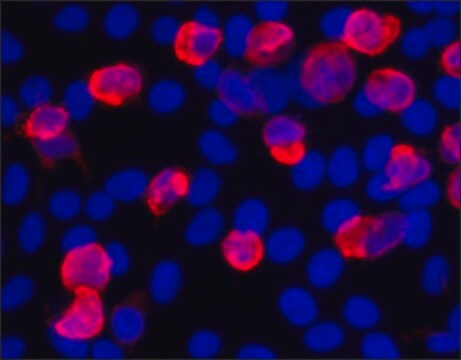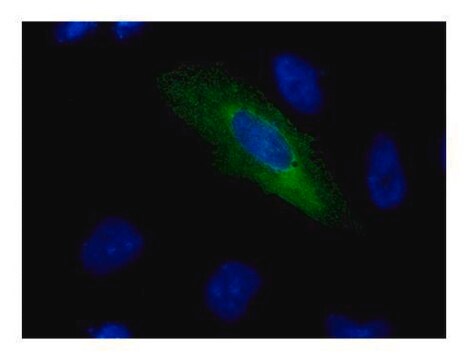V2260
Monoclonal Anti-V5-Peroxidase antibody produced in mouse
clone V5-10, purified immunoglobulin, lyophilized powder
Synonym(s):
Monoclonal Anti-V5
Sign Into View Organizational & Contract Pricing
All Photos(1)
About This Item
Recommended Products
biological source
mouse
Quality Level
conjugate
peroxidase conjugate
antibody form
purified immunoglobulin
antibody product type
primary antibodies
clone
V5-10, monoclonal
form
lyophilized powder
packaging
vial of 0.5 mL
concentration
5-11 mg/mL
technique(s)
western blot: 1:4,000-1:8,000
storage temp.
2-8°C
Looking for similar products? Visit Product Comparison Guide
General description
The V5 tag is a 14-amino acid long peptide sequence (GKPIPNPLLGLDST) that is derived from an epitope on the P and V proteins of simian virus 5 (SV5), which belongs to the paramyxovirus family. Monoclonal Anti-V5 Peroxidase conjugate reacts with V5-tagged recombinant fusion proteins expressed in transfected mmmalian cells or produced by in vitro translation.
Specificity
Recognizes V5 Tag (GKPIPNPLLGLDST) fusion proteins
Application
Suitable for immunoblotting.
Physical form
Lyophilized from a 0.01 M phosphate buffered saline solution, pH 7.4, containing 1% BSA and 0.05% MIT
Preparation Note
Prepared by the two-step glutaraldehyde method described by Avrameas, S., et al., Scand. J. Immunol., 8, Suppl. 7, 7 (1978).
Reconstitute with 0.5 mL of distilled water.
Not finding the right product?
Try our Product Selector Tool.
Signal Word
Warning
Hazard Statements
Precautionary Statements
Hazard Classifications
Skin Sens. 1
Storage Class Code
12 - Non Combustible Liquids
WGK
WGK 2
Flash Point(F)
Not applicable
Flash Point(C)
Not applicable
Choose from one of the most recent versions:
Already Own This Product?
Find documentation for the products that you have recently purchased in the Document Library.
Panayotis C Theodoropoulos et al.
Nature chemical biology, 12(4), 218-225 (2016-02-02)
A hallmark of targeted cancer therapies is selective toxicity among cancer cell lines. We evaluated results from a viability screen of over 200,000 small molecules to identify two chemical series, oxalamides and benzothiazoles, that were selectively toxic at low nanomolar
Steven F Baker et al.
Cell reports, 24(10), 2581-2588 (2018-09-06)
Adaptation of viruses to their hosts can result in specialization and a restricted host range. Species-specific polymorphisms in the influenza virus polymerase restrict its host range during transmission from birds to mammals. ANP32A was recently identified as a cellular co-factor
Vy Tran et al.
Nature microbiology, 5(12), 1490-1503 (2020-08-26)
Cells infected by influenza virus mount a large-scale antiviral response and most cells ultimately initiate cell-death pathways in an attempt to suppress viral replication. We performed a CRISPR-Cas9-knockout selection designed to identify host factors required for replication after viral entry.
Adriana López-Barradas et al.
American journal of physiology. Cell physiology, 311(5), C720-C734 (2016-11-03)
SMCTs move several important fuel molecules that are involved in lipid, carbohydrate, and amino acid metabolism, but their regulation has been poorly studied. Insulin controls the translocation of several solutes that are involved in energetic cellular metabolism, including glucose. We
Moonsup Lee et al.
The Journal of cell biology, 218(8), 2659-2676 (2019-07-05)
Cilia are critical for proper embryonic development and maintaining homeostasis. Although extensively studied, there are still significant gaps regarding the proteins involved in regulating ciliogenesis. Using the Xenopus laevis embryo, we show that Dishevelled (Dvl), a key Wnt signaling scaffold
Our team of scientists has experience in all areas of research including Life Science, Material Science, Chemical Synthesis, Chromatography, Analytical and many others.
Contact Technical Service









